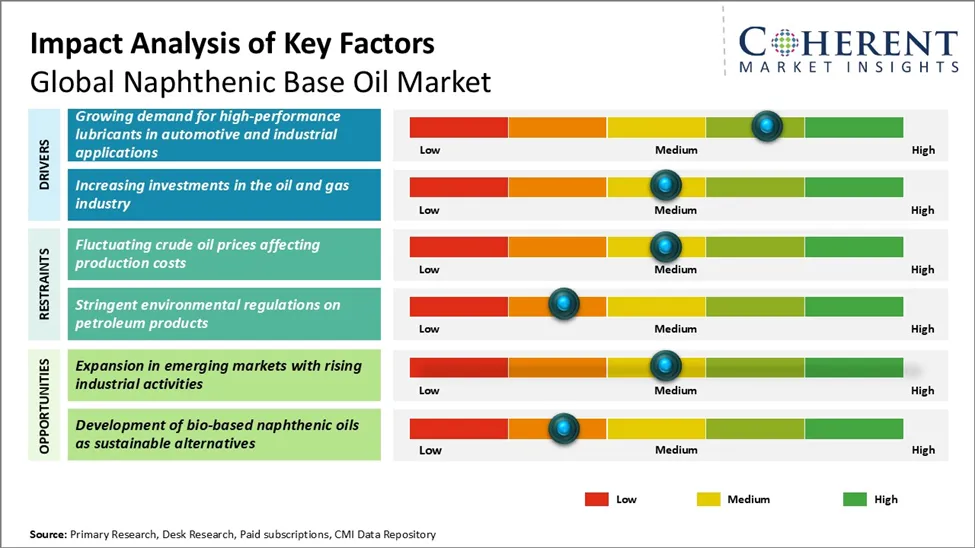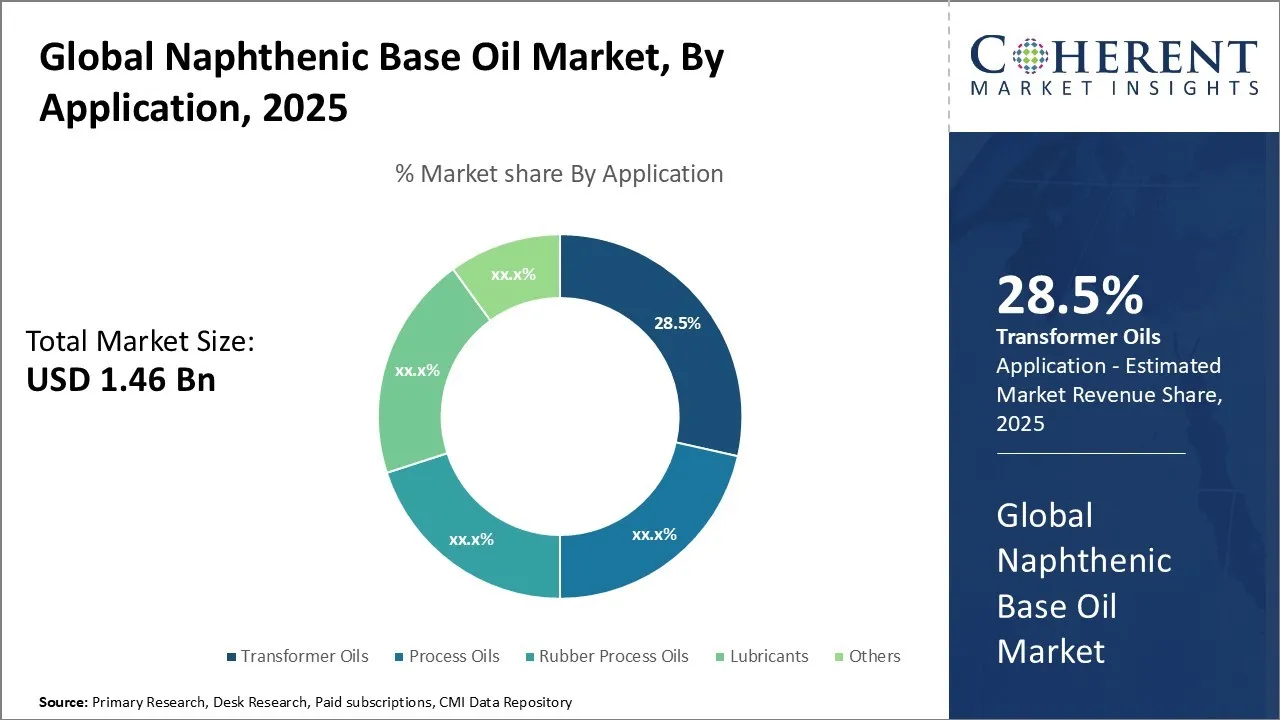Global Naphthenic Base Oil Market Size and Trends – 2025 - 2032
The Global Naphthenic Base Oil Market is estimated to be valued at USD 1.46 Bn in 2025 and is expected to reach USD 2.01 Bn by 2032, exhibiting a compound annual growth rate (CAGR) of 4.7% from 2025 to 2032.
Key Takeaways of the Naphthenic Base Oil Market:
- The transformer oils segment is projected to account for 28.5% of the global naphthenic base oil market share in 2025.
- The electrical & electronics segment is expected to represent 31.4% of the market share in 2025.
- The 35-60 SUS segment is anticipated to account for 27.4% of the market share in 2025.
- Asia Pacific is projected to lead the market with a 35% share in 2025, followed by the Europe region, which is expected to hold a 27.5% share in 2025.
Market Overview:
The base oil finds widespread application in the lubricant industry, especially for industrial lubricants. Steady demand from the automotive and industrial sectors is expected to drive market revenue over the forecast period. The market is expected to witness positive growth over the next few years. The growing automotive industry in developing regions of Asia Pacific and Latin America is expected to boost demand. Furthermore, increasing industrialization and focus on manufacturing are other key factors expected to support naphthenic base oil consumption. Naphthenic base oils offer superior properties like better low-temperature fluidity and oxidation stability compared to other conventional base oils. This makes them suitable for high-performance lubricants used in heavy-duty machinery and automotive engines.
Application Insights - Reliability and Efficiency Drive Transformer Oil Dominance
In terms of application, the transformer oils segment is expected to contribute 28.5% share of the market in 2025, due to their vital role in the electrical infrastructure. Naphthenic base oils are specifically formulated for use as transformer fluids due to their excellent electrical insulating properties and high flash points. As electricity demand rises worldwide in tandem with increasing urbanization and industrialization, major investments are being made to modernize aging power grids and expand transmission networks. The need for high-performing and reliable transformers is growing considerably to efficiently transport and distribute electricity over long distances.
End-use industry Insights - Expanding Use in Automotive and Electronics Augments Process Oil Demand
In terms of end-use industry, the electrical & electronics segment is expected to contribute 31.4% share of the market in 2025, due to expanding use of naphthenic process oils. Within this segment, naphthenic base oils see substantial use in the automotive and electronics industries for various demanding applications. In automotive manufacture, naphthenic process oils act as lubricants and coolants during metal forming, machining, and assembly operations. Their high oxidation stability keeps components cool and prevents sludge even under heavy mechanical stresses and frictional heat. This maintains dimensional accuracy and surface finish of intricate automotive parts.
Grade Insights - Uniform Viscosity and Low Volatility Fuel 35-60 SUS Grade Dominance
In terms of grade, the 35-60 SUS segment is expected to contribute 27.4% share of the market in 2025, due to its balanced properties ideal for diverse applications. The narrow 35-60 SUS viscosity range delivers uniform performance without significant variances caused by fluctuations in temperature or operations. This provides greater consistency for lubrication and ensures equipment runs smoothly within normal operating parameters.
Regional Insights

Need a Different Region or Segment? Download Free Sample
Asia Pacific Naphthenic Base Oil Market Trends
The Asia Pacific region is expected to dominate the naphthenic base oil market, accounting for a 35% share by the end of 2025. This strong growth is primarily driven by expanding crude oil refining capacities and rapid industrialization in key economies such as China and India. Additionally, the rising demand from the lubricant manufacturing and transportation industries is fueling market expansion.
Europe Naphthenic Base Oil Market Trends
Europe is poised to capture 24.5% of the naphthenic base oil market share by the end of 2025, positioning it as the fastest-growing region in this sector. This rapid expansion is driven by a robust ecosystem of leading oilfield service providers and independent oil producers. Additionally, government policies supporting domestic oil production, coupled with an established industry presence, have further strengthened Europe's market position.
Naphthenic Base Oil Market Outlook for Key Countries
U.S. Naphthenic Base Oil Market Trends
The U.S. stands as a pivotal market for naphthenic base oils, primarily due to their extensive application in automotive lubricants and various industrial sectors. The escalating demand for high-performance lubricants is a notable trend, driven by technological advancements in engine designs and the need for superior lubrication solutions. With companies like Chevron Corporation playing a crucial role. Chevron expanded its production capabilities to meet the rising consumer demand for advanced lubricants. Notably, Chevron began producing 4 centiStoke API Group III base stocks at its Richmond, California refinery, enhancing the availability of high-quality base oils for the automotive sector.
China Naphthenic Base Oil Market Trends
China stands as the largest consumer of naphthenic base oil, primarily due to its expansive automotive and manufacturing sectors. The government's initiatives toward modernization in these industries have significantly propelled this demand. The market has witnessed substantial growth, bolstered by increased investments in refining technologies aimed at enhancing the production of high-quality naphthenic oils. A notable contributor to this development is Sinopec, one of China's leading oil and gas enterprises.
Germany Naphthenic Base Oil Market Trends
Germany's robust automotive industry and renowned engineering excellence significantly drive the consumption of naphthenic base oils within the country. The nation's dedication to technological advancements in machinery and vehicles necessitates the use of high-performance lubricants, thereby bolstering market growth. A key contributor to this sector is Zeller+Gmelin, a German company specializing in industrial lubricants. Zeller+Gmelin has partnered with Nynas, a leading producer of naphthenic base oils, to enhance the quality of their lubricant products. This collaboration has enabled Zeller+Gmelin to leverage Nynas' expertise in naphthenic oils, known for their excellent solvent power and superior low-temperature properties compared to paraffinic base oils. The partnership underscores the importance of reliable suppliers in maintaining the high standards of Germany's automotive and industrial sectors.
India Naphthenic Base Oil Market Trends
India's naphthenic base oil market is experiencing rapid expansion, primarily fueled by the burgeoning automotive and textile industries. A significant trend contributing to this growth is the rising awareness of the benefits associated with high-quality lubricants. A notable contributor to this growth is Indian Oil Corporation Limited (IOCL), one of the country's leading oil companies. In 2023, IOCL expanded its base oil plant in Haldia by adding a 255,000-ton-per-year API Group II production unit. This strategic investment not only increased the company's production capacity but also played a pivotal role in bolstering the overall supply of high-quality base oils within the Indian market.
Brazil Naphthenic Base Oil Market Trends
Brazil is emerging as a notable market for naphthenic base oils, driven by the expansion of its agricultural and automotive sectors. The increasing demand for efficient lubricants in these industries has been a key driver of market growth. A significant contributor to this development is Petróleo Brasileiro S.A. (Petrobras), Brazil's state-controlled oil company. As one of the major players in the global naphthenic base oil market, Petrobras has been instrumental in meeting the rising domestic demand.
Market Players, Key Devlopment, and Competitive Intelligence

Get actionable strategies to beat competition: Download Free Sample
Key Developments:
- In November 2022, Calumet, Inc. has entered into a long-term distribution partnership with SIP Specialty Oils and Fluids to distribute Calumet's naphthenic base oils in Europe. This collaboration aims to expand Calumet's presence in the European market by leveraging SIP's marketing, sales, warehousing, and support services for the full range of Calumet's naphthenic products. Additionally, SIP is authorized to distribute Calumet's paraffinic base oils, solvents, and esters throughout Europe.
Top Strategies Followed by Global Naphthenic Base Oil Market Players
- Established Players: Leading companies in the market heavily invest in research and development to innovate and introduce high-performance products. They focus R&D efforts on developing base oils with enhanced properties like improved oxidation stability, viscosity indexes, and better low temperature performance. This allows them to sustain tightening specifications from automotive and industrial sectors.
- For instance, major players also pursue strategic alliances and partnerships with other major oil companies as well as equipment manufacturers and OEMs in industries like power, marine, and drilling. Such partnerships help them gain access to new customers, boost technical expertise, and expand global distribution networks. This strengthens their presence across lucrative market segments.
- Mid-Level Players: Mid-sized companies focus on delivering competitively priced, quality naphthenic base oil products. They target price-sensitive consumers in emerging markets by optimizing production processes to keep costs low. This allows them to offer reliable lubricant solutions at affordable price points and gain market share.
- Small-scale players: By concentrating on specific industries or applications, small-scale producers can tailor their products to meet unique customer requirements, establishing themselves as specialists in particular segments. The smaller size of these companies allows for quicker adaptation to market changes and customer demands, enabling them to offer customized solutions and foster strong client relationships.
Emerging Startups - Naphthenic Base Oil Industry Ecosystem
- Innovative Technologies: Technological innovation is driving the market forward, with advancements in refining techniques like hydrocracking and catalytic dewaxing enabling the production of high-purity naphthenic oils that offer enhanced performance. These developments have broadened the use of naphthenic oils, especially in sectors that require specialized lubricants. For instance, Nynas AB, a company specializing in naphthenic specialty products, has invested in product development, focusing on catalyst and hydrotreatment technologies. This has led to the introduction of transformer oils and other products that comply with strict environmental standards.
- Sustainable Solutions: The industry is increasingly focusing on sustainability, with companies implementing eco-friendly practices and creating renewable products. For example, Nynas has introduced transformer and tire oils partially made from bio-based feedstock, reducing dependence on fossil resources and promoting sustainable development. Additionally, Nynas and OQ Chemicals have collaborated to enhance naphthenic base oil capacities in Europe, emphasizing sustainable production methods to meet the rising demand for process oils.
Market Report Scope
Naphthenic Base Oil Market Report Coverage
| Report Coverage | Details | ||
|---|---|---|---|
| Base Year: | 2024 | Market Size in 2025: | US$ 1.46 Bn |
| Historical Data for: | 2020 To 2024 | Forecast Period: | 2025 To 2032 |
| Forecast Period 2025 to 2032 CAGR: | 4.7% | 2032 Value Projection: | US$ 2.01 Bn |
| Geographies covered: |
|
||
| Segments covered: |
|
||
| Companies covered: |
Nynas AB, Royal Dutch Shell, Calumet Specialty Products Partners, Ergon Inc., Chevron Corporation, Repsol S.A., ExxonMobil Corporation, H&R Group, Avista Oil, Petrobras, Lubricon Industries, Eastern Petroleum, Indo Petro Chemicals, Panama Petrochem Ltd., Gandhar Oil Refinery India Limited, Apar Industries Limited, HollyFrontier Corporation, Pentagon Lubricants, and Witmans Industries Pvt. Ltd. |
||
| Growth Drivers: |
|
||
| Restraints & Challenges: |
|
||
Uncover macros and micros vetted on 75+ parameters: Get instant access to report
Market Dynamics

Discover market dynamics shaping the industry: Download Free Sample
Naphthenic Base Oil Market Growth Factors
Growing demand for high-performance lubricants in automotive and industrial applications
The automotive industry has been growing tremendously over the past few decades. With increased incomes and standards of living, more people are able to afford personal vehicles. At the same time, technology in automobiles has also advanced significantly. Modern engines are designed to be more powerful and fuel-efficient. However, they also place greater thermal and frictional stresses on components. This has boosted the need for advanced lubricants that can withstand higher pressures and temperatures within the engine. Naphthenic base oils form the backbone of many high-performance automotive lubricant formulas. They exhibit desirable properties such as high viscosity index, high film strength, and thermal stability. This allows lubricants made from naphthenic oils to protect the engine for longer durations without breaking down.
Market Challenge - Fluctuating crude oil prices affecting production costs
The global naphthenic base oil market has been facing rising production costs due to fluctuations in crude oil prices in international markets. As naphthenic base oils are manufactured from crude oil feedstocks, volatility in crude oil prices directly impacts the input costs for naphthenic base oil producers. Over the past few years, benchmark international crude oil prices have witnessed significant fluctuations depending on the demand-supply dynamics and geopolitical factors. Any increase in crude oil prices drives up the raw material procurement expenditure for naphthenic base oil manufacturers. On the other hand, prices of finished naphthenic base oils cannot be increased immediately considering the competitive nature of the market. This squeeze in margins has been a major challenge for the players in naphthenic base oil market. Rising costs have constrained the profitability of the manufacturers.
Market Opportunity - Expansion in emerging markets with rising industrial activities
The global naphthenic base oil market is witnessing new avenues of growth in the form of emerging economies experiencing rising industrialization. Many developing regions such as Asia Pacific, Latin America, and the Middle East are witnessing higher investment inflows in core sectors such as manufacturing, construction, mining, transportation etc. This is leading to increased demand for industrial lubricants and greases. Since naphthenic base oils are superior lubricants and find wide applications as industrial greases and metalworking fluids, their consumption is increasing in developing markets. The lubricant manufacturers are Expanding their naphthenic base oil requirement to cater to the thriving end-use industries in developing regions. This burgeoning demand from emerging markets with rising industrial footprints provides excellent expansion opportunities for naphthenic base oil producers looking to tap high growth regions.
Analyst Opinion (Expert Opinion)
- The naphthenic base oil market is expected to witness steady growth in the coming years. The automotive industry will continue dominating demand for naphthenic base oils used in engine and transmission applications. Growing vehicle production and mileage in developing countries of Asia Pacific and Latin America will drive lubricant consumption. However, stricter emission norms pushing for synthetic and semi-synthetic lubricants may hamper naphthenic base oil sales to some extent.
- Refineries are focusing on upgrading facilities to boost naphthenic base stock yields. Adoption of new production technologies could help meet the rising demand. Opportunities exist in industrial applications like metalworking fluids, greases and hydraulic fluids. Recovery in manufacturing sectors worldwide is likely to support volume growth. Demand for specialty grades from the process oil segment may also rise.
- The naphthenic base oil market is anticipated to be led by Asia Pacific during the forecast period. China, India, and other developing Asian nations will accelerate demand owing to rising industrial activities and automotive production. Europe will remain a significant regional market backed by maintenance demand from sizable vehicle parc and production. Meanwhile, Middle Eastern producers are spending on capacity expansions to take advantage of the market growth.
Market Segmentation
- Application Insights (Revenue, USD Bn, 2020 - 2032)
-
- Transformer Oils
- Process Oils
- Rubber Process Oils
- Lubricants
- Others
- End-use Industry Insights (Revenue, USD Bn, 2020 - 2032)
-
- Electrical & Electronics
- Automotive
- Industrial
- Petrochemical
- Others
- Grade Insights (Revenue, USD Bn, 2020 - 2032)
-
- 35-60 SUS
- 80-130 SUS
- 200-300 SUS
- 400-800 SUS
- Above 1200 SUS
- Regional Insights (Revenue, USD Bn, 2020 - 2032)
- North America
- U.S.
- Canada
- Latin America
- Brazil
- Argentina
- Mexico
- Rest of Latin America
- Europe
- Germany
- U.K.
- Spain
- France
- Italy
- Russia
- Rest of Europe
- Asia Pacific
- China
- India
- Japan
- Australia
- South Korea
- ASEAN
- Rest of Asia Pacific
- Middle East
- GCC Countries
- Israel
- Rest of Middle East
- Africa
- South Africa
- North Africa
- Central Africa
- North America
- Key Players Insights
- Nynas AB
- Royal Dutch Shell
- Calumet Specialty Products Partners
- Ergon Inc.
- Chevron Corporation
- Repsol S.A.
- ExxonMobil Corporation
- H&R Group
- Avista Oil
- Petrobras
- Lubricon Industries
- Eastern Petroleum
- Indo Petro Chemicals
- Panama Petrochem Ltd.
- Gandhar Oil Refinery India Limited
- Apar Industries Limited
- HollyFrontier Corporation
- Pentagon Lubricants
- Witmans Industries Pvt. Ltd.
Share
Share
About Author
Yash Doshi is a Senior Management Consultant. He has 12+ years of experience in conducting research and handling consulting projects across verticals in APAC, EMEA, and the Americas.
He brings strong acumen in helping chemical companies navigate complex challenges and identify growth opportunities. He has deep expertise across the chemicals value chain, including commodity, specialty and fine chemicals, plastics and polymers, and petrochemicals. Yash is a sought-after speaker at industry conferences and contributes to various publications on topics related commodity, specialty and fine chemicals, plastics and polymers, and petrochemicals.
Missing comfort of reading report in your local language? Find your preferred language :
Transform your Strategy with Exclusive Trending Reports :
Frequently Asked Questions
EXISTING CLIENTELE
Joining thousands of companies around the world committed to making the Excellent Business Solutions.
View All Our Clients

